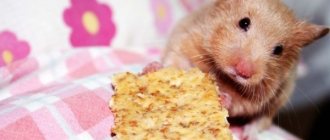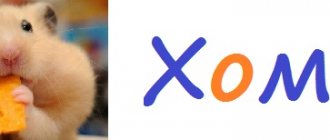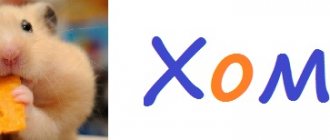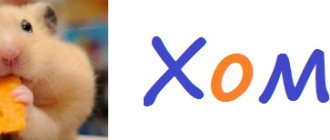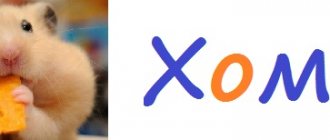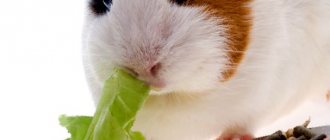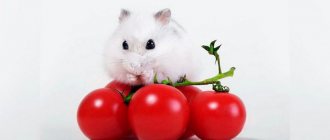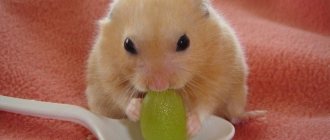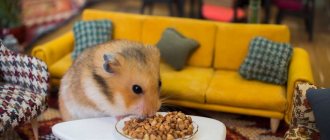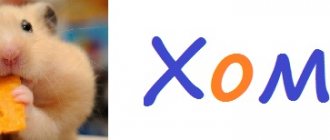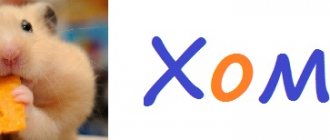- home
- Nutrition
09.05.2018
Hamsters are known to be omnivores. Therefore, many breeders feed their pets homemade food from their refrigerator, and rarely does anyone think about whether hamsters can have bread and other flour products, because it consists of grain, and grain is the basis of a rodent’s diet in nature. What are the benefits and harms of grain flour for a hamster?
Is it possible to give a hamster bread and baked goods?
It is important to know that almost every type of bread contains yeast, which is very harmful to the rodent. Fermentation of yeast in the gastrointestinal tract can lead to:
- alcohol intoxication;
- nausea, vomiting;
- diarrhea with bloody discharge;
- rectal prolapse;
- flatulence;
- respiratory failure, suffocation;
- illness and even cardiac arrest;
- lack of attention;
- refusal of food;
- disorientation in space;
- lethal outcome.
IMPORTANT! Excessive consumption of bread by a hamster can lead to obesity and even diabetes.
Excess weight leads to diseases of the joints, bones, lungs and heart. Bakery products contain a lot of carbohydrates. And even more so, it is forbidden to give your hamster bread that has become moldy.
Should I give it black?
The composition of black bread does not contain such an increased content of pathogens for the stomach as in a wheat product.
However, fresh rye bread is also not an indicator for feeding a rodent. A high percentage of acidity can attack the intestines and be a serious irritant to the gastric mucosa.
The fermentation process that occurs in the digestive organs can last up to 4 hours, and due to the long intestines of a rodent, the breakdown into enzymes can be delayed, thereby causing obstruction.
Repeated consumption of a slice of black bread by a rodent can lead to stomach upset, ulcers, lethargy, or increased aggressiveness.
White
White bread, especially fresh bread, is harmful to hamsters. The flour from which this bread is baked contains a lot of starch. In addition, food bleach is added to white flour, which does not bring any benefit to the animal .
If you regularly feed your hamster white bread, there is a risk of developing pathologies:
- necrosis of renal tubules;
- malfunction of the adrenal glands;
- pancreatic diseases;
- malfunction of the thyroid gland.
Cookies, buns and baked goods
Sweet confectionery products are strictly prohibited.
Dyes, preservatives and emulsifiers are not natural vitamins and, if consumed frequently, can accumulate in the body, gradually shortening the pet’s lifespan.
The low nutritional value of the muffin cannot compensate for the necessary complex of vitamins, and a high degree of additives harmful to the hamster will lead to an exacerbation of diseases.
It is forbidden to give your pets bread that shows signs of mold.
Rye
This bread, in addition to rye flour, also contains wheat flour, and it is very harmful for hamsters. In addition, bread is highly acidic and is bad for your hamster's intestines, causing gas and constipation .
The salt present in rye bread can cause heart and kidney disease in rodents.
In addition to the above, rye bread causes:
- diarrhea;
- toxin poisoning due to constipation;
- lethargy, irritability, apathy.
What about black?
To answer this question, it is necessary, as in the case of white, to consider the composition of the product:
- rye flour;
- purified water;
- yeast.
Despite the belief that flour is beneficial for rodents, some people forget that it is a source of starch. Despite this myth, rye flour also only benefits humans, but not hamsters. Even despite the minimal starch content in such flour, it is still there. As mentioned above, a small piece is enough for hamsters to disable the digestive system. Rye bread is considered more sour than its wheat counterpart. And increased acidity can cause the development of serious diseases in the animal. According to zoologists, the following consequences are possible:
- diarrhea and constipation;
- the hamster has difficulty defecating or the stool looks different than usual;
- with constipation, the hamster’s body enters an amount of toxins that can lead to death;
- changes in behavior up to a passive lifestyle;
- gas formation, bloating.
As stated earlier, too much yeast can cause a number of problems with the GI system. Therefore, it is highly not recommended to give black or white bread to your pet.
Dried (crackers)
Hamsters' teeth grow throughout their lives; rodents have a need to constantly grind them down on something hard. In the cage, he grinds his teeth with a chalk or mineral stone, and while eating, you can give the rodent to eat crackers.
You can make dried wheat bread for this purpose; when heat treated, it loses its harmful properties. It’s just worth making the crackers yourself, since the store-bought product contains many substances that are unhealthy for rodents: salt, spices, starch, flavor enhancers and flavorings. Once in the animal's body, they can cause:
- heart diseases;
- kidney disease;
- diseases of the gastrointestinal tract;
- allergies.
ATTENTION! In the store you can buy bran bread for your hamster that does not contain harmful additives. It will also be useful to add bran and grains to homemade crackers.
Do you make your pet’s croutons yourself or buy ready-made ones?
Flour products
No buns (homemade or store-bought), waffles, cakes or other baked goods should be given to hamsters. Pies, pancakes, pancakes are prohibited - all this is fried in oil, which will not benefit rodents. It is better to treat them with bran, which is allowed (in reasonable quantities).
Dry pasta containing a lot of sticky starch should not be offered to hamsters. In addition, they are very hard, even for sharp hamster teeth. Sometimes boiled noodles are introduced into the diet, but only high-quality ones, made exclusively from premium flour with the addition of water. When cooked, the starchy substances from the pasta are transferred into the water, so there will be no harm from them.
Bread
Crispbread is on the list of products not recommended for rodents. Despite their low calorie content, such products will cause significant harm to the animal. Typically, the breads consist of dry fibers that can injure the inside of your hamster's cheeks .
Very often, manufacturers add salt and sugar to bread, and this negatively affects the rodent’s body - they can cause diabetes and harm the functioning of the liver and kidneys. If the bread also contains additional spices, they can irritate the walls of the hamster’s stomach.
Is bread allowed for animals?
It would seem that bread is considered one of the most natural products in the human diet for a reason, and it consists of grain suitable for animals. But with this diet, hamsters often become depressed and lose their healthy appearance. Flour products are allowed to be included in the pet’s diet, but in strictly limited quantities.
Despite the obvious difference between the diet of a wild animal and a domestic pet, balanced food is the basis of health. The hamster must have access to balanced food.
In addition, you are allowed to include a number of additional products in your friend’s daily diet, for example:
- meat products;
- porridge;
- good quality vegetable crops;
- low-fat fish;
- fruits without or low in nitrates.
In addition to the permitted products, there is a list of those that are not recommended to be given to your pet. However, which category bakery products belong to remains a mystery to many.
What is better not to give
Not all baked goods are suitable for pets. It is worth highlighting several prohibited options.
Yeast products
When they are introduced into the diet, fermentation begins in the stomach. There is bloating and excessive gas formation. This negatively affects the general condition of the animal.
Bread with various additives
Baking with garlic or onions provokes irritation of the gastric mucosa. These products also contain a substance that reduces hemoglobin in the animal’s body, so there is a risk of developing anemia.
From corn and soybeans
These products are quite difficult to digest. Due to their consumption, the animal’s digestion process is disrupted. Vomiting and diarrhea may occur.
Sweet pastry with jam, nuts and other additives
The following is not allowed:
- jam;
- chocolate;
- nuts;
- raisins;
- jam.
At first, the pet likes these buns, but soon after eating them, heaviness appears in the stomach and pain occurs.
Fried flour products
Flatbreads fried in a frying pan with added fat should not be given to your pet. Such food is very poorly digested and leads to a deterioration in the dog’s general condition.
Conclusion
So can hamsters eat bread? White fragrant loaf, even if it looks appetizing to you, is not recommended to be given to a hamster. The same goes for aromatic black bread and ready-made crackers. Homemade, hand-cooked crackers will help diversify your rodent's diet.
Remember that proper care and a healthy diet can extend your pet's life up to three years, while feeding non-recommended foods, including sweet rolls, can shorten your hamster's life to up to a year. Be careful about those you tamed!
Did you like the article? Share with friends: [supsystic-social-sharing >
- Related Posts
- Can a hamster eat coconut, kiwi, pineapple, mango?
- Can hamsters eat grapes?
- What fruits can hamsters eat?
Prohibited for use
Foods that should never be given to Yorkies:
- Fatty meats (lamb, pork) place a high burden on the liver.
- Smoked and salted foods contribute to the development of diseases of the kidneys, liver, and pancreas.
- Potatoes, legumes, and white cabbage provoke flatulence.
- Oatmeal and pearl barley cause allergies.
- Milk is poorly digestible and leads to problems with the gastrointestinal tract.
- Sweets, bread, pasta are the cause of the development of diabetes, diarrhea, and dermatitis.
- Bones lead to injuries to the walls of the digestive organs.
- Freshwater fish does not allow iron to be absorbed.
In addition, juices, mushrooms, tea and coffee, alcohol, citrus fruits, raw eggs, onions, and fried foods should not be included in the Yorkshire Terrier's menu.
Other dough products
Probably not a single dog will refuse the opportunity to eat a sweet bun spread with butter. But no responsible breeder will feed a pet this way.
To begin with, baked goods are rich in sugar. That is, even with rare consumption it can cause serious obesity. True, for hunting and working dogs this is not so critical - they will quickly spend excess calories. But for decorative pets this is certain death.
It's sad, but you can't bake it
In addition, buns often contain chocolate, nuts, raisins, jam and various sweet powders. All of them may well cause stomach upset. So why risk the health and life of your pet for momentary pleasure? After all, it is impossible to predict how such pampering will turn out.
Can hamsters have celery?
Yes, hamsters can be given celery. There are many questionable reports that celery can cause strangulation in hamsters. To avoid such cases, you can give your hamster very thin slices of celery to keep the fibers short enough.
https://www.youtube.com/watch?v=BhQiETe2p7g
Celery contains many beneficial substances and minerals such as vitamin C, beta-carotene, manganese and many others that will help your pet stay in good shape. Celery also contains coarse fiber, which the hamster's digestive system is well adapted to. As with other vegetables, feed your pet celery in reasonable small amounts and not every day to avoid stomach upset.
How to give water to a dzhungarik
Water is necessary for the full life of any organism, and the Djungarians are no exception (even though they originally lived in dry steppes and deserts). The fluid that your hamster gets from vegetables and fruits is sometimes not enough.
Especially in hot weather, he may experience extreme thirst. For drinking, it is better to purchase a drip drinker, so your pet will have round-the-clock access to liquid. It is better to take purified water, as boiled water or just from a tap can be too hard.
Can hamsters eat grapes?
Hamsters can eat grapes, and they love this healthy fruit. Grapes are berries, but not citrus fruits, so they are completely safe for hamsters. However, if you are keeping diabetic dwarf hamsters, then this product is not suitable for regular feeding.
To make sure grapes are safe for hamsters, you can crush them and see if they have seeds, or, as a last resort, remove them yourself. Grape seeds can pose a choking hazard to hamsters and should always be removed first. And as previously mentioned, dwarf hamster species should not be fed large amounts of sugary foods, and grapes contain a lot of sugar.
What grapes do hamsters prefer? There is no evidence that hamsters prefer green or red grapes, so it comes down to personal preference. You can feed your hamster grapes every few days, and they certainly shouldn't be the main staple of his diet. Eating too many fruits and vegetables, which contain fiber, can cause stomach upset and diarrhea.
Also be careful - hamsters love to hoard and store food. So use fresh food sparingly and check every few days that your hamster has eaten all of his food.
What not to feed Djungarian hamsters
Not every product is safe for the health of a tiny rodent. It is not advisable for hamsters to eat the following foods at home:
- legumes (peas, beans, etc.);
- nuts (pine, Brazil and almond);
- vegetables (garlic, onions, cabbage, potatoes);
- fruits (persimmon, citrus, pomegranate, mango, kiwi and pineapple);
- raw fish and meat;
- sausages;
- pasta;
- cheese and milk;
- mushrooms.
Many of these products are not just harmful, but also dangerous to the life of the dwarf. The tiny rodent is very sensitive even to microdoses of strong acids and nitrates. Therefore, he should not eat almonds, watermelons, etc.
Due to the increased risk of constipation, hamsters are prohibited from eating persimmons and other astringent fruits. Seasonings cause diarrhea in Djungarians, which means they should not be fed spicy food from the master’s table. Cabbage and beans are contraindicated for hamsters. They provoke increased gas formation, which leads to the rapid death of animals.
The liver of small rodents is not able to cope with very fatty foods. Therefore, you should not feed your Djungarian hamster avocado, cream, sour cream, butter and large portions of seeds.
Sausages and sausages contain spices, soy and starch. And pasta, although it has a safe composition, can injure the cheek pouches, as a result of which the rodent will require serious treatment.
Djungarians are cute, funny rodents that are often kept as pets. And although ornamental animals do not cause much trouble for their owners, they must eat high-quality and balanced food.
Djungarian hamsters are usually indiscriminate in their food and eat everything that is offered to them, so the owner must carefully monitor the pet’s diet. Djungarians should not be given bread, either wheat or rye.
How to make a hamster's diet
The hamster's menu must be designed so that its body receives proteins, fats, carbohydrates, vitamins, minerals, and water in the required quantities. After all, the needs of an animal change depending on age, period of life, and time of year. For example, at the end of winter - beginning of spring, the main menu is supplemented with fish oil (0.3 g), yeast (0.2 - 0.4), salt (0.2 - 0.3 g).
The daily portion of food depends on the size and age of the pet. Small and young hamsters eat more than older ones. For example, if an animal weighs 10–14 g, then per day it must eat a portion of food that is 70–80% of its weight, and sometimes more than 100%. As you age, the amount of food you eat changes.
A hamster's appetite depends on its condition, external conditions, and breed. The gastronomic preferences of each animal are different. Therefore, you need to make sure that he eats all the food in the feeder and does not choose tidbits.
Veterinarians have calculated the daily dose of various products depending on the season:
| Feed | Season | |||
| Winter | Spring | Summer | Autumn | |
| Vegetables | 50 g | 50 g | 50 g | 50 g |
| Roots | 15 g | 15 g | 10 g | 10 g |
| Dairy | 10 ml | 10 ml | 10 ml | 10 ml |
| Cereals | 20 g | 20 g | 20 g | 20 g |
| Greenery | — | — | 300 g | 300 g |
| Hay | 10 g | 10 g | — | — |
The daily amount of food depends on the age of the hamster:
| Products | Adult hamsters | Young animals |
| Cereals | 20 g | 10 g |
| Roots | 40 g | 20 g |
| Bran | 7 g | 5 g |
| Dairy | 10 ml | 5 ml |
| Greenery | 200 g | 100 g |
| Hay | 30 g | 20 g |
The animal should be fed with one type of food at the same time. For example, at 7 o’clock in the morning he eats greens, vegetables, herbs, protein foods, and at 19.00 – grain mixture, boiled cereals, some hay and treats. Pregnant females can eat 3–4 times a day at equal intervals. The evening meal should contain 40% of the daily diet.
Rodents sleep all day, and in the evening, that’s when they are fed. The hamster eats 1 time in the evening or 2 times - in the evening and in the morning.
If the hamster recovers quickly, then you need to temporarily exclude bread, sweets and fatty foods from the menu or significantly reduce their amount. You also need to make your pet move more.
How much do pet hamsters eat?
In a normal environment, a hamster can feed itself quite independently and even make supplies. Pets do not have this opportunity, which means the owner must take care of this.
Let's consider what products should be in the diet of pets:
- parsley or dill;
- dried fruits;
- nuts;
- carrots and radishes;
Did you know? Hamsters are a rare species of animal that are born with teeth. In addition, they are constantly growing, so the animals need to periodically grind them down.
- bell pepper;
- cabbage;
- protein food;
- grain crops;
- strawberries or wild strawberries;
- grape.
Everyone knows that the quality of food and the mode of its consumption form the basis for a prosperous life for pets, including hamsters.
The task of a good owner is to provide his pet with the necessary conditions for a full and long life.
The basic rule to follow when feeding your pet: you can give everything that he can find while living in the wild. The more natural products there are in an animal’s diet, the better for it.
The main types of foods to feed your hamster at home.
- Cereals - wheat, oatmeal, buckwheat, barley, corn. They can be given as whole grains, flakes, or as a porridge cooked in water. Sunflower and pumpkin seeds. Legumes, except red beans.
- Vegetables. Raw carrots, zucchini, pumpkin, bell peppers, eggplants, radishes, radishes. You can also give vegetables boiled without adding salt. It is better to lightly boil beets, broccoli, and cauliflower.
- Greenery, grass, tree leaves. Parsley, dill, lettuce, plantain, young nettle, clover. Young tree branches (apple, pear, birch, maple).
- Fruits and berries. Apples, pears, bananas, cherries, cherries, strawberries. They readily eat rose hips and currants. They love dried fruits (raisins, dried apricots, prunes, pieces of dried apples and pears). Occasionally you can give plums, apricots, and grapes. It is better to remove the seeds.
- Dairy products (low-fat and unsweetened kefir, cottage cheese, natural yogurt).
- Eggs, chicken, fish. Twice a week you can give a boiled egg, a piece of boiled lean chicken or boiled fish. Cook without salt and spices.
- It is better to buy bugs, worms and special insects at a pet store. Hamsters love earthworms, but if you dig them up in a flower bed, you can give your pet an infection.
Your pet is a nocturnal animal, you need to remember this. During the day he sleeps, and at night he eats, plays, exercises on a “simulator,” stores supplies, and sharpens his teeth. Therefore, the best option is to feed the baby twice a day. In the evening - the main meal, a hearty breakfast. In the morning, before bed, have a light dinner.
The amount of food that should be given to an animal at one time depends on the type and size of the rodent. When feeding twice a day, the Syrian is given one tablespoon of the feed mixture, and the Djungarian is given one teaspoon. Campbell's hamsters and other dwarf species feed similarly.
He will hide all the food that the hamster does not eat at one time in the pantry “for a rainy day.” Periodically review these supplies and remove perishable foods so that the animal does not get poisoned. Be sure to put something fresh in place of the “seized valuables”. Otherwise, the baby may become seriously stressed because all his reserves have disappeared, and he will die of hunger in the long, cold winter.
If you are training a baby or teaching him, for example, to use a running wheel, you need to stock up on “goodies.” Sunflower seeds or cookies are suitable for this purpose. Sometimes you can feed your baby a banana. But since rodents constantly need to wear down their teeth, they must eat more solid food. In addition, bananas contain a lot of sugar.
Repeat “fruit” days no more than 1-2 times a week.
Final information
As you can see, the greatest benefit for hamsters will come from whole grain bread, prepared at home in the form of crackers. In dry form, animals can be given both wheat and rye types of the product. Crackers, even from white bread, are not harmful to the animal. In addition, with the help of crackers, your pet can easily grind off growing teeth.
Pets do not have problems with the gastrointestinal tract system from consuming this product. On the contrary, hard types of bread help stimulate its work. Pets are by nature adapted to eating solid foods, so soaking crackers even with the best intentions is not recommended. A homemade product will be as beneficial as possible for the rodent.
When choosing a diet for a friend, it is important to remember the list of prohibited foods. If the owner has already given bread before reading the information, do not panic. It is important to remember that the lifespan of hamsters depends on the quality of their care. Therefore, the answer to the question originally posed in the article is positive only in the case of a rodent eating a dry version of bread.
Thanks to the knowledge gained, you can improve the quality of rodent care with the help of a well-balanced diet. And, as is known, the life expectancy of animals depends on the quality of care.
What I am a master at is talking incessantly about hamsters. I have three hamsters at home, and my husband has a pet rat. That’s how we live, the six of us eat, the six of us sleep :)
Source
Is white bread allowed for pets?
Traditionally, such a product is made from flour, yeast and water. And white flour is the most important source of starch compounds. It is harmful to the animal because it is primarily considered a heavy type of carbohydrate. With a one-time supply, in case of excess, the hamster may experience bloating or diarrhea. When bread is included in the diet, diseases such as metabolic disorders or disorders of the gastrointestinal tract can occur. It is also important to know that during the production process flour is additionally processed to increase its shelf life. As a result, due to such treatment, the pet will not receive valuable vitamins, but only starch.
Because of this approach, the following types of diseases and problems can develop:
- necrosis of the kidney canals;
- pancreatic pathology;
- thyroid problems;
- pathologies of the adrenal glands.
Yeast in increased quantities is also harmful to the animal. A big piece for a hamster may be a small crumb for a human. If the formation of yeast in the stomach of an animal exceeds the norm, then this causes a fermentation process. Which, in turn, becomes a consequence of alcohol intoxication.
In this case, a number of dangerous diseases and consequences are possible:
- nausea, vomiting and bloating;
- gas formation in the colon, which can cause respiratory failure;
- diarrhea and refusal to eat;
- heart diseases;
- disorientation in the surrounding space;
- death of a rodent.
Can hamsters eat meat?
There is a widespread belief among the owners of this animal that if you feed it meat, cannibalism will eventually manifest itself. In general, homas are herbivores. Nevertheless, they will gobble up meat products with joy.
Hamsters can have meat, but it must be fresh, lean and always boiled.
What will be harmful:
- pork;
- beef;
- fatty lamb.
Many owners of hamsters think that adding meat to their diet is not worth it, but the little pranksters need animal protein, which fills them with energy and helps them develop.
A little hamster just needs protein. Correctly calculating the diet is quite simple. You need to weigh your pet and give him food in the amount of 80 percent of his weight. Sometimes the diet can be 100 percent of the weight.
You should not give raw product to rodents; it may contain bacteria and parasites. It is pre-boiled in clean water. The ideal option is chicken, but pork and beef are best avoided. Fatty meat negatively affects the liver and causes obesity.
The food must be fresh, otherwise it will negatively affect the pet’s well-being.
Lard is fat, and it is difficult for both humans and hamsters to digest. It contains a lot of animal fat, which increases the amount of cholesterol and has no beneficial contribution.
You should not give dried meat, it contains a lot of spices and salt, which corrode the stomach from the inside.
